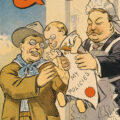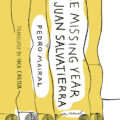Alice Neel: a Radical Portrait

Alice Neel: the Art of Not Sitting Pretty
by Phoebe Hoban
Hardcover, $35
St. Martin Press, 2010
Alice Neel was a handful. She was a visual artist, a proto-feminist, a Thirties radical, and a Sixties icon. She was the mother of four children, an abused woman, and a beloved grandmother. She worked for the WPA and appeared with Johnny Carson. She was perhaps the most influential portraitist of her time, though she was more or less ignored until late in her life. All in all, she is a tough character to pin down.
Alice Neel: The Art of Not Sitting Pretty by Phoebe Hoban does a good job of handling all these different facets, although it takes almost 500 pages (including endnotes) to do so. Sometimes Hoban gets so wrapped up in the men and the children, the sloppy clothes and the ratty apartments, that the art comes in second. At other times, the analysis of Neel’s work blots out the woman who suffered to create it. And the paintings themselves are almost a distraction — one turns again and again to the color plates in the book, the way one returns to a favorite song.
Hoban’s challenge is to balance the story of a long, varied life with insight into the fascinating work. For the most part, she succeeds. The author suggests that Neel’s progressive politics and artistic style stemmed from the same source: a passionate belief in the common people. Not pretty people, not important people, but real people. Harsh, even crude, the portraits show people who reflect the conflicts and realities of their times.
Born in 1900, Neel was raised in small-town Colwyn, Pennsylvania, and grew to hate it. Upon striking out on her own, she attended art school in Philadelphia and married the Cuban artist Carlos Enriquez. Maintaining her artistic vision in the face of blatant discrimination as a female artist, combined with constant financial trouble, deepened Neel’s commitment to leftist activism. When the marriage ended, Enriquez remained in Cuba with their child and Neel relocated to Spanish Harlem. She struggled herself and chose to live among others who struggled. Neel then joined the Communist Party in 1935 and remained a member for the rest of her life.
During the ensuing depression, the artist refined her representative skills and chose subjects who reflected her political commitments. The 1935 portrait of waterfront organizer Pat Whalen shows a forceful man whose powerful fists rest on a newspaper headlined “Steel, Coal Strikes Set.” Her equal empathy for the solitary individual can be seen in TB Harlem, a portrait of a young man collapsed in bed after a tuberculosis treatment.
This work found some success. Her down-to-earth style fit in well with the accepted approach of Social Realism and her paintings regularly appeared in galleries and received good notices. Her paycheck, however, came from the government. Neel joined the Public Works of Art Project, which later became the Federal Art Project of the Works Progress Administration, and remained with the WPA until 1942. Hoban writes:
Social Realism mirrored the New Deal itself. The artwork funded by the Works Project Administration under the Roosevelt administration was intended to be “public work,” work the public could relate to and that would be placed in pubic venues such as post offices, schools, and hospitals; hence the many street, factory, and strike scenes. It was an art form that reflected the economic conditions that created it. Its unique government patronage was the direct result of the Depression and on the WPA program, the artists themselves became members of the very working class they were heroically depicting.
By the Fifties, Neel’s modicum of success evaporated. The rise of the hyper-masculine Abstract Expressionists saw her representational work ignored. She continued to paint, filling all the extra space in her apartment with stacks of paintings. The cover photo of Hoban’s book is a terrific black and white photo of Neel seated cross-legged in front of dozens of startling portraits.
The Sixties, however, saw an explosion of sexual freedom and ideological radicalism and the resurgence of figurative art. Neel was in her element. She sought out important people in the art world and the art world embraced her gritty portraits. Even when her subjects came to include the rich and powerful — she did two covers for Time magazine — her commitment to tough insight remained unchanged. She treated Andy Warhol and poet Frank O’Hara with the same blunt hand as painted her Latino neighbors thirty years earlier.
If Neel had ever worried about what others thought, she had certainly stopped worrying by the time fame arrived. One of her favorite subjects toward the end of her life was the female nude—but these are not classical nudes, the traditional object of beauty, but nudes as a body full of lived experience. These paintings are not Madonnas, they are real women: round, fleshy and often exhausted. Neel’s work played a key role toward the radical re-imagining of the female body in a feminist age.
As with a number of important creative women, including Frida Kahlo and Sylvia Plath, Neel came to be lionized by the women’s movement. Unlike Kahlo and Plath, however, Neel was alive to enjoy her status, and enjoy it she did. She lectured regularly, won important commissions, and appeared with Johnny Carson. (Can you imagine Plath on The Tonight Show?) And she never cleaned up her language for anyone.
“Neel never stopped being the rebel artist, but as she entered her seventies, she became more image-conscious, packaging herself as a kind of grandmotherly muckraker, as politically aware as she was outrageously outspoken,” Hoban writes. “Invited everywhere, she took her show on the road, becoming a cult figure on the college lecture scene, famed for her idiosyncratic off-color remarks and quick wit. When a man heckled her during a panel discussion by shouting, ‘The reason women don’t succeed is that they don’t have balls,’ Neel instantly replied, ‘Women have balls. They’re just higher up.'”
Neel’s long artistic journey is, in a sense, easier to follow than the details of her complicated personal life. Neel was feisty and committed, but not always likeable. Her lonely battles as a woman artist in poverty and isolation are admirable; but her neglect of her daughter and failure to protect one of her sons from abuse seem problematic. Hoban handles these issues admirably, by presenting all the contradictory and unpleasant details as the facts they are.
In many ways, Neel was what would be called a passionate mother. She suffered terribly when her first child — a ten-month old girl — died of diphtheria. When her estranged husband kept their second daughter in Cuba, Neel had a nervous breakdown. After she recovered, however, she made little effort to keep in touch with the girl. Years later, when her grown daughter attended one of Neel’s lectures, the artist apparently did not recognize her.
Another troubling aspect of Neel’s story is the fact of domestic violence. Neel lived with photographer Sam Brody for two decades. Brody fathered her second son, but subjected both Neel and her older boy to years of abuse. Here Neel acted in the same way so many victims of domestic violence have acted, enduring the abuse out of a complex of fear and the inability to change her situation. One is always wary of blaming the victim, but most victims were not public feminist radicals. It is hard to square the woman who was so fierce in her artistic independence, so committed to radical social change, with the woman who was incapable of standing up for herself or her child in her private life.
Neel’s place in the artistic pantheon is becoming more fixed. Hoban notes that Neel’s work has been exhibited, either alone or in group shows, every single year since 1984. With this new biography, Hoban presents the fascinating and unsettling life behind the work. On their own, the Communist membership, the difficulty with her parental role, the sloppy dress and rough tongue are not themselves notable. They simply make her the kooky lady down the street. It is the art that makes her worth a study of this magnitude.
About Francie Noyes
After a career in journalism with stints as business editor and political reporter, Francie Noyes now writes poetry and essays. Her poems have appeared in White Pelican Review, Key West: a Collection and The Anthology of New England Writers and her book reviews in Alehouse and Galatea Resurrects. She facilitated at the Scottsdale International Film Festival for eight years.





